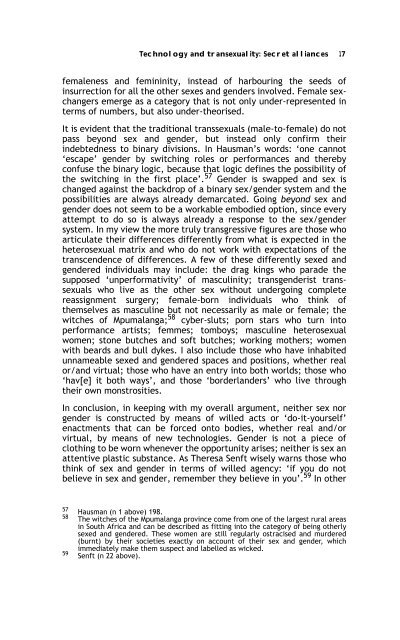Sex, Gender, Becoming - PULP
Sex, Gender, Becoming - PULP
Sex, Gender, Becoming - PULP
You also want an ePaper? Increase the reach of your titles
YUMPU automatically turns print PDFs into web optimized ePapers that Google loves.
Technology and transexuality: Secret alliances 17<br />
femaleness and femininity, instead of harbouring the seeds of<br />
insurrection for all the other sexes and genders involved. Female sexchangers<br />
emerge as a category that is not only under-represented in<br />
terms of numbers, but also under-theorised.<br />
It is evident that the traditional transsexuals (male-to-female) do not<br />
pass beyond sex and gender, but instead only confirm their<br />
indebtedness to binary divisions. In Hausman’s words: ‘one cannot<br />
‘escape’ gender by switching roles or performances and thereby<br />
confuse the binary logic, because that logic defines the possibility of<br />
the switching in the first place’. 57 <strong>Gender</strong> is swapped and sex is<br />
changed against the backdrop of a binary sex/gender system and the<br />
possibilities are always already demarcated. Going beyond sex and<br />
gender does not seem to be a workable embodied option, since every<br />
attempt to do so is always already a response to the sex/gender<br />
system. In my view the more truly transgressive figures are those who<br />
articulate their differences differently from what is expected in the<br />
heterosexual matrix and who do not work with expectations of the<br />
transcendence of differences. A few of these differently sexed and<br />
gendered individuals may include: the drag kings who parade the<br />
supposed ‘unperformativity’ of masculinity; transgenderist transsexuals<br />
who live as the other sex without undergoing complete<br />
reassignment surgery; female-born individuals who think of<br />
themselves as masculine but not necessarily as male or female; the<br />
witches of Mpumalanga; 58 cyber-sluts; porn stars who turn into<br />
performance artists; femmes; tomboys; masculine heterosexual<br />
women; stone butches and soft butches; working mothers; women<br />
with beards and bull dykes. I also include those who have inhabited<br />
unnameable sexed and gendered spaces and positions, whether real<br />
or/and virtual; those who have an entry into both worlds; those who<br />
‘hav[e] it both ways’, and those ‘borderlanders’ who live through<br />
their own monstrosities.<br />
In conclusion, in keeping with my overall argument, neither sex nor<br />
gender is constructed by means of willed acts or ‘do-it-yourself’<br />
enactments that can be forced onto bodies, whether real and/or<br />
virtual, by means of new technologies. <strong>Gender</strong> is not a piece of<br />
clothing to be worn whenever the opportunity arises; neither is sex an<br />
attentive plastic substance. As Theresa Senft wisely warns those who<br />
think of sex and gender in terms of willed agency: ‘if you do not<br />
believe in sex and gender, remember they believe in you’. 59 In other<br />
57 Hausman (n 1 above) 198.<br />
58 The witches of the Mpumalanga province come from one of the largest rural areas<br />
in South Africa and can be described as fitting into the category of being otherly<br />
sexed and gendered. These women are still regularly ostracised and murdered<br />
(burnt) by their societies exactly on account of their sex and gender, which<br />
immediately make them suspect and labelled as wicked.<br />
59 Senft (n 22 above).
















